Top Rankings
Northern Lights Academy Cooperative School District ranks among the top 20% of public school district in Minnesota for:
Category
Attribute
Diversity
Most diverse schools (Top 1%)
Student Attention
Lowest student:teacher ratio (Top 1%)
For the 2025 school year, there are 2 public high schools serving 43 students in Northern Lights Academy Cooperative School District. This district's average high testing ranking is 1/10, which is in the bottom 50% of public high schools in Minnesota.
ÎÛÎÛÂþ» High Schools in Northern Lights Academy Cooperative School District have an average math proficiency score of 20% (versus the Minnesota public high school average of 36%), and reading proficiency score of 20% (versus the 51% statewide average).
Minority enrollment is 37% of the student body (majority Black and American Indian), which is equal to the Minnesota public high school average of 37% (majority Hispanic and Black).
Overview
This School District
This State (MN)
# Schools
3 Schools
1,177 Schools
# Students
43 Students
310,035 Students
# Teachers
6 Teachers
18,776 Teachers
Student : Teacher Ratio
7:1
7:1
District Rank
Northern Lights Academy Cooperative School District, which is ranked within the bottom 50% of all 522 school districts in Minnesota (based off of combined math and reading proficiency testing data) for the 2021-2022 school year.
Overall District Rank
#456 out of 527 school districts
(Bottom 50%)
(Bottom 50%)
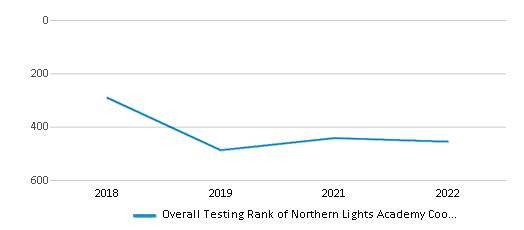
Math Test Scores (% Proficient)
≤20%
45%
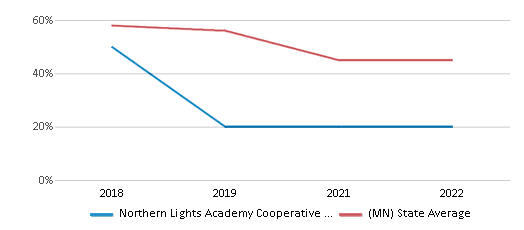
Reading/Language Arts Test Scores (% Proficient)
≤20%
51%
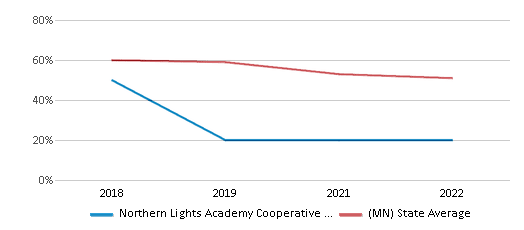
Science Test Scores (% Proficient)
21-39%
41%
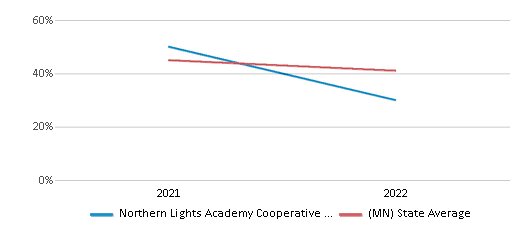
Students by Ethnicity:
Diversity Score
0.56
0.57
# American Indian Students
3 Students
6,364 Students
% American Indian Students
7%
2%
# Asian Students
n/a
19,892 Students
% Asian Students
n/a
7%
# Hispanic Students
2 Students
35,225 Students
% Hispanic Students
5%
11%
# Black Students
3 Students
34,141 Students
% Black Students
7%
11%
# White Students
27 Students
196,402 Students
% White Students
63%
63%
# Hawaiian Students
n/a
317 Students
% Hawaiian Students
n/a
n/a
# Two or more races Students
8 Students
17,694 Students
% of Two or more races Students
18%
6%
Students by Grade:
# Students in PK Grade:
-
229
# Students in K Grade:
-
120
# Students in 1st Grade:
2
204
# Students in 2nd Grade:
5
210
# Students in 3rd Grade:
3
264
# Students in 4th Grade:
4
305
# Students in 5th Grade:
-
384
# Students in 6th Grade:
6
3,144
# Students in 7th Grade:
6
11,219
# Students in 8th Grade:
3
12,649
# Students in 9th Grade:
6
67,716
# Students in 10th Grade:
7
69,634
# Students in 11th Grade:
1
69,942
# Students in 12th Grade:
-
74,015
# Ungraded Students:
-
-
District Revenue and Spending
Total Revenue
$1 MM
$15,547 MM

Spending
$2 MM
$16,179 MM
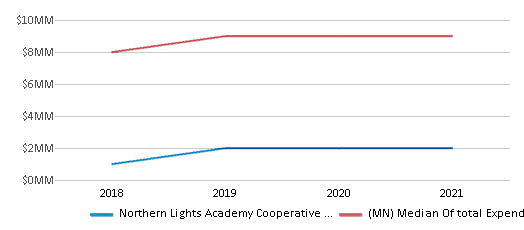
Best Northern Lights Academy Cooperative School District ÎÛÎÛÂþ» High Schools (2025)
School
(Math and Reading Proficiency)
(Math and Reading Proficiency)
Location
Grades
Students
Rank: #11.
Northern Lights Academy
Special Education School
(Math: ≤20% | Reading: ≤20%)
Rank:
Rank:
2/
Bottom 50%10
302 14th Street
Cloquet, MN 55720
(218) 878-3060
Cloquet, MN 55720
(218) 878-3060
Grades: K-12
| 12 students
Rank: n/an/a
Nla-carlton
Special Education School
405 School Ave
Cloquet, MN 55720
(218) 878-3060
Cloquet, MN 55720
(218) 878-3060
Grades: 4-12
| 31 students
Recent Articles

Year-Round Or Traditional Schedule?
Which is more appropriate for your child? A year-round attendance schedule or traditional schedule? We look at the pros and cons.

Why You Should Encourage Your Child to Join a Sports Team
Participating in team sports has a great many benefits for children, there is no doubt. In this article you will learn what those benefits are.

White Students are Now the Minority in U.S. ÎÛÎÛÂþ» Schools
Increasing birth rates among immigrant families from Asia and Central and South America, combined with lower birth rates among white families, means that for the first time in history, public school students in the United States are majority-minority. This shift in demographics poses difficulties for schools as they work to accommodate children of varying language abilities and socio-economic backgrounds.





